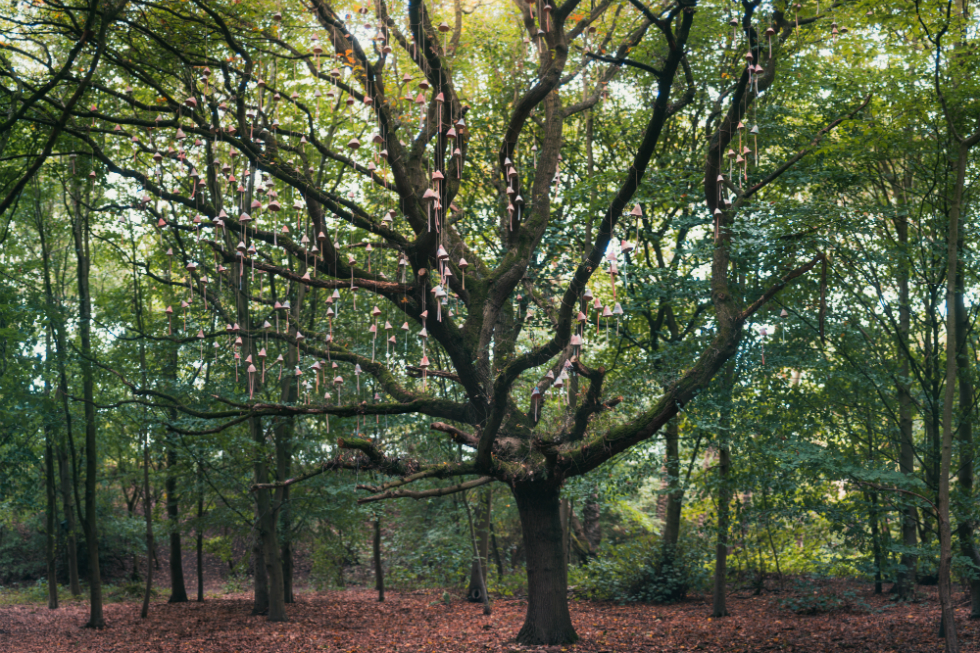“Slipping through some thinly veiled realm…” Serena Korda’s The Bell Tree – Reviewed

Fairies, gods and ‘thin places’ exist at Speke Hall, finds Stephanie Gavan; all you’ve got to do is look up and listen…
Arriving at the visitor centre, I am handed a map of the grounds by a soft-spoken girl behind the desk. My eyes widen as she springs to my side, tracing the route with her finger. The grounds seem vaster than I remember as a child. I wonder if I should have worn more suitable shoes. After 10 minutes or so I find myself approaching a wooden gate at the edge of the estate. I consult my map before entering and then, silence. Encased by trees, the light oozes through the branches. It creates a sort of slowed down, strobe effect as I walk deeper into the woodland. In a trance-like state, I almost miss the installation itself. I stop myself and gaze up to find the branches of a magnificent oak tree adorned with hundreds of mushroom-like bonnets. There is something ominous about their suspension. I think of witch trials. A mass of pale pink and blue ghosts subtly swaying as women’s voices chant and hiss in my ears. Every now and then I find myself turning around just to check. I’m still alone.
The Bell Tree (2018) is a multi-sensory installation by artist Serena Korda commissioned by the National Trust as part of its Trust New Art programme, which aims to connect communities with heritage in the city through contemporary art. The work consists of 300 porcelain mushroom bells, each one handmade and hung from an old oak. Accompanying this is a downloadable soundscape made in collaboration with South Liverpool choral group Mostly Madrigals, North East a cappella group Mouthful, and the Bell Ringers of St. Michael’s Church. An unusual site for contemporary art, Speke Hall’s woodlands date back to the time of William the Conqueror, over 1,000 years ago. Steeped in history, and known locally as a hotspot for hauntings, the estate seems like an appropriate location for the equally unusual concerns of Korda. Working across performance, sculpture and sound, her practice explores forgotten histories and folklore, ritual and tradition.
Through my earphones, a herd of voices chant “dead man’s bells, dead man’s bells” – one of the many names assigned to the bluebell flower on account of its poisonous nature. In Spring, bluebells can be seen to carpet the ground of the forest, transforming it into a sea of purple and blue. At the threshold of Autumn, however, that palette has been exchanged for warmer tones.
The dawn of November brings its own sense of witchery; amplifying the mysticism at the core of Korda’s work. Through further reading, I made some interesting discoveries. It’s said that fairies ring the bluebells to call meetings; and if you overhear them, you risk being spirited away, never to be seen again. The plant is known through scientific communities by its Latin name, hyacinthoides non-scripta, which is borrowed from the hyacinth flower of Greek mythology. As the story goes, this flower first appeared from the blood of the dying prince Hyacinthus. His lover, the god Apollo, shed tears that marked the petals of the flower with the word ‘alas’ as a sign of grief.
Giving equal importance to the imaginative and rational mind, Korda creates balance between scientific and spiritual domains, connecting what can and cannot be seen or heard. Reading through the visitors guide, the phrase ‘thin places’ jumped out at me. After some research I discovered it’s origin in Celtic folklore: “Heaven and Earth are only three feet apart, but in thin places, that distance is even shorter”. Previously explored in her sound sculpture for Glasgow International (2016), The Bell Tree is a continuation of Korda’s investigation into these thin places. Here, in this woodland, there is a definite sense of slipping through some thinly veiled realm. The chanting becomes spell-like and looking up, I’m drawn back to my Catholic upbringing: head-tilted towards the altar as a reminder that there is something much bigger than you. Something that you, in your smallness, could never fully comprehend, only sense.
My phone runs out of battery and I am transported back to the damp earth; my time with the fairies rudely interrupted by the roaring of planes departing from the nearby airport. Yes, I definitely should have worn different shoes.
Stephanie Gavan is a recent graduate of Liverpool-based literature organisation Writing on the Wall’s 12-week Write to Work programme, and is a #BeACritic alumna
See Serena Korda’s The Bell Tree at Speke Hall, Liverpool, until Sunday 28 July 2019. Open daily from 10.30-4pm
A smaller version of The Bell Tree is located in Bluecoat’s garden, free Mon-Sun 11-6pm daily. The Bell Tree is a co-commission between Trust New Art and Bluecoat
All images courtesy of photographer Chris Egon Searle





